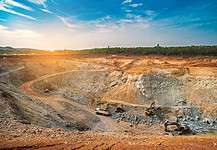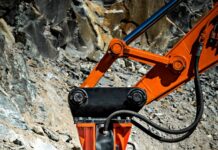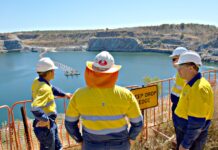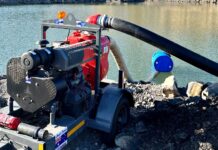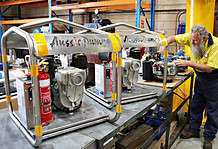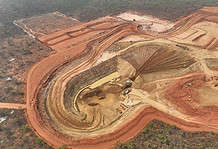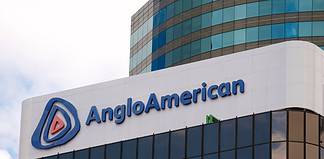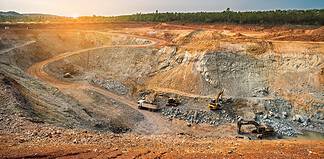Image: Australasian Railway Association.
BY AMY BLOM
RAIL is set to boom in mining, with several rail-reliant iron ore and coal mines schedules for development in WA and QLD, and a renewed focus on innovation. However, the industry continues to be challenged by a skills shortage.
Rail has entered a golden age, particularly within the mining industry, but it is still struggling to attract young talent, according to Australasian Railway Association (ARA) chief executive Danny Broad.
Mr Broad, who has previously warned of a skills shortage, said there had been a huge increase in rail investment, which was good for the country, but presented challenges if the industry was not prepared.
“It’s the golden era of rail at the moment, there is so much investment going on in both Australia and New Zealand; we forecast there is more than $100 billion of investment in new rail infrastructure – so that’s passenger and freight – over the next 10 years,” Mr Broad said.
This included four iron ore mines currently scheduled or already under development in WA’s Pilbara region by mining giants – Rio Tinto, BHP, FMG, and Roy Hill, as well as a number of coal mines in QLD.
Even more rail projects could be on the horizon for Australia’s mining sector.
In January this year it was announced Talison Lithium, rail operator Arc Infrastructure, and the Government’s South West Development Commission had cooperated on a pre-feasibility study examining the reopening of a disused section of rail in WA to carry lithium concentrate from Talison’s Greenbushes mine to Kemerton, Bunbury and Kwinana, and to support the state’s lithium industry.
The study found the $150 million rail option was financially competitive with Talison’s current plan of hauling concentrate out of Greenbushes by road.
“What a long-term pipeline of work does is provide the opportunities for companies, like contractors, to invest in their people because they know there’s work over a long period, it’s not lumps coming and going,” Mr Broad said.
“It’s really great for both Australia and New Zealand that this money is being invested, but it’s creating challenges, especially in skills and resources in terms of a shortage.
“That is especially for customers who are planning these major investments and their project teams; for the contractors whose role it is to build this new infrastructure; and for the supplier and manufacturers who supply the rolling stock, or other components and parts for that new infrastructure.”
Mr Broad said the increasing number of large new developments were also challenging in terms of operations.
“When you have bigger networks, you need more people operating them and you also need more people maintaining them,” he said.
“So it’s not just building the jolly things; once they’re built you’ve got to run them for the next 10 or 20 years, and you need more people in terms of operation and maintenance to ensure that they run efficiently.”
Establishing a Skills Pipeline
According to Mr Broad, part of the reason the rail industry was not prepared for the growth in the mining industry was the lack of an established pipeline.
“You find it in a lot of industries in that there was market failure in terms of bringing on new people and training them in the 80s, 90s and so forth,” Mr Broad said.
“Prior to then, you had government agencies who were doing all the training, cadetships, and apprenticeships, but that reduced down over a period of time, so all these cadets and apprentices who had gone through are now in their forties and fifties, and there isn’t a big wave coming in behind.
“It’s really important that we promote the rail industry to schools, parents, universities and colleges, because there’s such a variety of jobs in the rail industry, especially now when there’s so much investment going on.”
ARA sounded the alarm back in November, with the release of the Australasian Railway Association Skills Capability Study, prepared by BIS Oxford Economics.
The study found there was overwhelming evidence that there was a fast developing skills crisis that was deepening with every new rail project.
It found the inevitable result would be a substantial blow out in project costs and unavoidable delays in project delivery, and that the issues were being exacerbated by an ageing workforce and the “stop-start nature of rail investment.”
The report’s key recommendation to addressing the “conundrum” was to establish a taskforce, made up of senior bureaucrats, industry chief executives, and training sector leaders, as a mechanism to achieve greater cohesion between jurisdictions for country-wide outcomes with a strong industry engagement.
Its purpose would be to facilitate the development of an Australasian Rail Industry Pipeline of rail projects, which would be tasked with the purpose of mapping skills required across construction, manufacturing, operations and maintenance.
The taskforce would drive reform in education and training systems, and adding its weight to initiatives such as establishing branding partnerships with related industries across transport, mining and manufacturing.
Following the report’s release, Federal shadow minister for infrastructure and transport Anthony Albanese said Labor would create a taskforce that works with the rail industry and training sector to come up with solutions for the shortage.
According to Mr Broad, other organisations have begun to address the looming skills shortage themselves, such as Pacific National in QLD, which has a demand for more train drivers due to the increased need for coal haulage.
Pacific National launched its program to train its own freight drivers back in May 2018, with the 12-month training program beginning in July.
When the first batch of 25 recruits finish the course in July this year, they will be awarded a Certificate IV qualification in train driving.
At the time, Pacific National’s coal division president Brett Lynch said the program was launched to keep pace with the forecast growth in demand for freight given the ageing workforce of drivers around the country.
Rail Remains Best Option
Despite the prospect of a skills shortage, Mr Broad said the onslaught of new projects was still a good thing for the industry, and in turn, rail was still the transport option of choice for the mining sector.
“We see it as the backbone of a supply chain network, whether it’s coal or iron ore – getting the product from mine to port, or mine to a production facility – rail provides that transport mode to maximise the capacity,” Mr Broad said.
Despite safety issues in rail being thrown into the spotlight following two train derailments in WA, BHP and Mineral Resources, Mr Broad said accidents were rare.
“Rail is an extremely safe transport mode – road produces 14 times more accidents than rail – and rail has a rigorous training and accreditation standard,” he said.
“It is the most cost-effective solution, it ensures faster delivery, and it’s more reliable and safer than other transport modes.
“In the Pilbara they deliver more than 800mtpa of iron ore to the ports for export and on the east coast we’ve got coal both in the Hunter and the Bowen Basin – together that’s close to 400mtpa of coal transported by rail – so it’s huge.”
Rio Tinto’s Autohaul is the first automated, heavy haul rail network in the world. Image: Rio Tinto.
Innovative Rail Solutions
Rail has also been making waves in the mining sector through a number of innovations, such as Rio Tinto’s deployment of autonomous trains at its WA iron ore operations in late December last year.
In a world first, the mining giant successfully deployed AutoHaul, establishing the world’s largest robot and first automated heavy-haul, long distance rail network.
Since completing the first loaded run in July, Rio Tinto has steadily increased the number of autonomous journeys across its WA operations, with more than 1 million km now travelled autonomously.
Rio Tinto Iron Ore Rail, Port and Core Services managing director Ivan Vella said the safe and successful deployment of AutoHaul across the miner’s network was a strong reflection of the pioneering spirit inside Rio Tinto.
“It’s been a challenging journey to automate a rail network of this size and scale in a remote location like the Pilbara, but early results indicate significant potential to improve productivity, providing increased system flexibility and reducing bottlenecks.”
According to Rio Tinto, over the coming months the miner would continue to refine its autonomous operations to ensure it was able to maximise value.
Rio Tinto confirmed it was working closely with drivers and did not expect to make any redundancies in 2019 as a result of the deployment of AutoHaul.
Mr Broad, who welcomed the deployment, said it was one of a number of new measures being adopted by major miners as they continued to research and innovate to improve safety and productivity.
“I think if you look at the Pilbara where you have what we call heavy haul operations, they’ve actually invested a lot of money into research and technology over the years,” Mr Broad said.
“They are the best at heavy haul in the world, and how they achieve that is through research and new technology where they’ve looked at things like automation as well as digitalisation.
“For example, through digitalisation they’re able to get real-time data, and using the internet of things, support maintenance, their operation, and the autonomous operations.”
Mr Broad said innovations such as digitalisation meant miners were able to utilise condition-based maintenance to reduce lifetime costs.
“They can use predictive maintenance to eliminate service failures, because the last thing you want is for a train to break down halfway from mine to port,” he said.
“Through this real-time data they can also manage the operation of the train, so they can reduce the amount of fuel that the train needs for the operations.”
He said the new technologies applied to rail in the mining sector were unlikely to reduce the amount of skilled workers needed as they often changed jobs, rather than replacing them.





